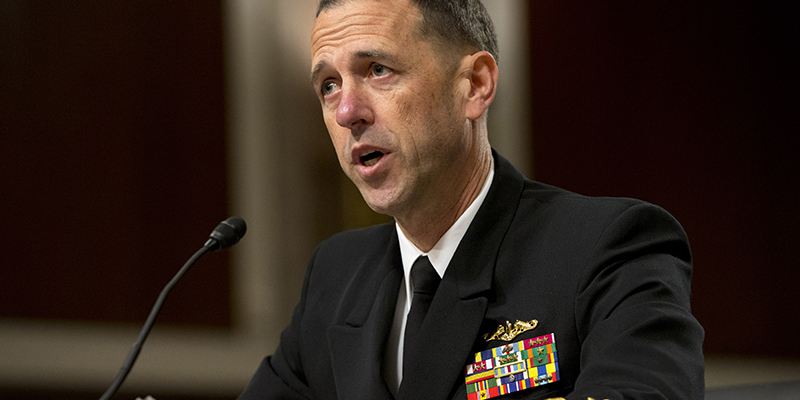
In this July 30, 2015 file photo, Navy Adm. John Richardson testifies on Capitol Hill in Washington. In his blueprint for a stronger Navy, the sea service’s new top boss, Richardson, is blunt about what he thinks matters most: nuclear punch. (AP Photo/Jacquelyn Martin, File)
In his blueprint for a stronger Navy, the sea service’s new top boss, Adm. John M. Richardson, is blunt about what he thinks matters most: nuclear punch.
Battling terrorists is today’s problem, but in looking toward a farther horizon, Richardson wants a Navy built to counter unpredictable future threats from other countries. No. 1 on his list is a new fleet of nuclear-armed submarines, known as “boomers,” that prowl the oceans as the quiet centerpiece of the nation’s nuclear force. The Navy plans to replace the current fleet of 14 Ohio-class boomers, which began service as early as 1981, with 12 next-generation subs.
“This is foundational to our survival as a nation,” Richardson writes in what he calls his design for the future, released Tuesday.
It also is a gigantic investment, estimated at $100 billion. Even one of the project’s biggest supporters, Sen. Richard Blumenthal, D-Conn., calls the cost “staggering.” And it happens to be just one of three efforts by the Pentagon to modernize the U.S. nuclear “triad” – new long-range bomber aircraft, new or upgraded land-based intercontinental ballistic missiles and new missile-toting submarines. The price tag for these, plus related upgrades and replacements, is likely to approach $348 billion by 2024, according to the Congressional Budget Office.
Richardson acknowledges the expense but argues it is part of the cost of doing business on the world stage.
“From a security standpoint in this day and age, a world-class nuclear capability” is required to be considered a great power, he said Dec. 31 in an Associated Press interview. Without it, “we could be threatened or coerced by another nation who could hold this nuclear threat over our heads,” he added.
Russia and China are both modernizing their nuclear forces, although not every expert agrees that this alone justifies to do the same, at huge expense. William J. Perry, defense secretary from 1994 to 1997, says the U.S. can adequately deter a nuclear attack with a slimmed down force of nuclear bombers and nuclear-armed submarines. He favors scrapping the Air Force’s land-based missiles, or ICBMs.
Others say a combination of ICBMs and subs would be the right mix. In almost any proposed arrangement, the submarines would be part of the mix. That is because they are easily the least vulnerable to targeting by an enemy force, since they are nearly undetectable while on undersea patrol.
Richardson took over as the Navy’s chief of naval operations, its top job, in September after three years as head of naval nuclear propulsion programs, meaning he was responsible for the nuclear reactors that propel submarines and aircraft carriers, but not for the Navy’s nuclear weapons. He is a career submariner.
His focus on the Navy’s nuclear future may seem surprising at a time when the military’s agenda is dominated by the threat posed by the Islamic State and other terrorist groups, who are not in the nuclear game and may not be deterred by U.S. nuclear weapons. The Navy plays several roles in countering terrorist threats, including launching airstrikes from aircraft carriers, flying aerial reconnaissance missions and providing Navy SEAL teams as part of the military special operations forces in Afghanistan and elsewhere in the greater Middle East.
Richardson says the Navy must stay fully involved in countering terrorism, but he is convinced that it must also maintain a nuclear arsenal second to none.
Like most new service chiefs, Richardson spent his early weeks on the job developing a document that outlines his view of the service’s future. At the top of his list of ways the Navy must strengthen its combat power is the nuclear challenge, which he defines as maintaining and modernizing the nuclear submarine force.
He also cites international terrorist groups as a long-term threat to security and stability around the world, and he worries about North Korea making new advances in its nuclear weapons and missile programs. He says the nuclear deal that the U.S. and other world powers made with Iran “may curb its nuclear weapons ambitions,” but Tehran still poses threats in other ways, including with advanced missiles.
He says the Navy also is challenged by an accelerating range of technological change, including advances in genetic science and artificial intelligence.
“Our competitors are moving quickly, and our adversaries are bent on leaving us swirling in their wake,” he wrote. He mentions Russia and China as well as North Korea.
Amid this change, the U.S. faces a “return to great power competition” for the first time in 25 years, he says, with China seeking to develop a global reach and Russia asserting itself militarily, not just with its occupation of Crimea and incursion into eastern Ukraine but also its tough talk. “Their goals are backed by a growing arsenal of high-end warfighting capabilities, many of which are focused specifically on our vulnerabilities,” he wrote.
This is where nuclear weapons come in, Richardson says. The current fleet of Ohio-class submarines, armed with Trident II missiles and based at King’s Bay, Georgia, and Bangor, Washington, has already exceeded its projected 30-year lifespan.
“If we don’t reconstitute the undersea leg” of the nuclear triad, “then we’re not even at the table to discuss world affairs as a great power,” he said in the interview.
Filed Under: Aerospace + defense




